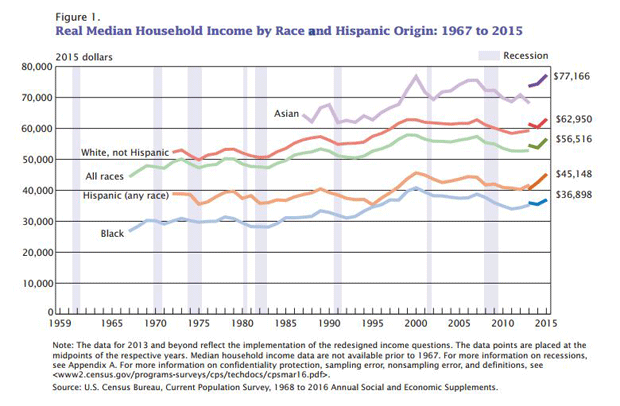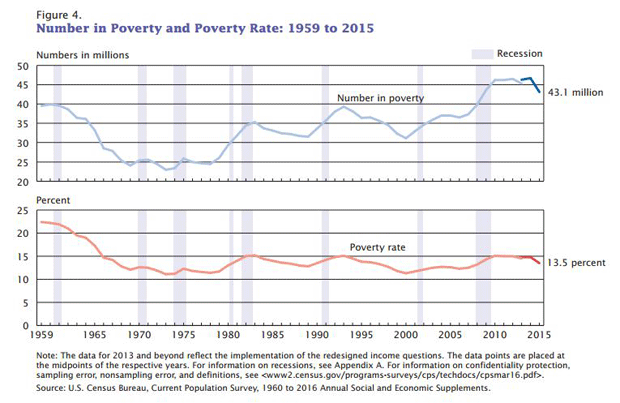An end to wage stagnation: American incomes jump 5.2%
After years of stagnant income, American families are at last catching a break.
Median household income jumped 5.2 percent last year, reaching $56,500, marking the first annual increase in median household income since 2007, before the recession started, the U.S. Census Bureau said Tuesday.
In addition, the poverty rate last year declined to 13.5 percent, a 1.2 percentage point decrease since 2014. It marks the largest annual percentage point drop in poverty since 1999.
Income stagnation had become a hallmark of the post-recession years, hobbling families who were facing higher expenses for everything from education to housing while their earnings went sideways. While good news at last, it remains to be seen whether the economy can deliver additional years of household income growth. Despite the income jump last year, American households are still earning 2.4 percent below what they brought home at their income peaks in 1999.
“If we lived in a world where we could get this kind of shared prosperity for four to five years in a row, then I’d be a happy camper,” Sheldon Danziger, president of the Russell Sage Foundation, which funds research on income inequality, said in an interview. “I think we have turned a corner on a very, very bad patch. We have basically recovered from the recession.”
Still, Danziger noted that incomes haven’t yet returned to their peaks at the end of the Bill Clinton administration. While the poverty rate has improved, it’s still higher than it was in 2000. While there’s still ground to regain, the improvements are a “vindication of the policies of the Obama administration,” he said, adding that the lower poverty rate points to the success of government programs such as Social Security and food stamps.
“It’s a rejection of the mantra first pushed 30 years ago about by Robert Rector at The Heritage Foundation and mimicked by Paul Ryan that we spent money on reducing poverty and poverty won,” he added.
Other economists heralded the income growth and poverty reduction, with the Economic Policy Institute’s Lawrence Mishel describing the report as “superb in almost every dimension.”
“If we get decent strong income growth in 2016, we’ll see the broad middle class have dug themselves out of the great recession,” Mishel said on a conference call to discuss the report. “We have to have economic policies that get wages growing and drop unemployment. That is really the key driver in my view of what we are observing.”
The reason for the improvement in household income is tied to higher employment, Census officials said. Wages also improved, with EPI economist Elise Gould noting that women’s inflation-adjusted wages rose 2.7 percent, while men’s rose 1.5 percent.
Households were helped by the current low-inflation environment, Mishel noted. A decline in energy prices is offsetting higher prices elsewhere, a trend that’s not likely to continue indefinitely. If inflation were closer to normal levels, household income would have likely increased only about 3 percent, EPI said.
Still, stark differences in earnings between income groups, races and gender are evident. The top 5 percent of all earners recorded income of $214,500 last year, compared with $117,500 in 1967, adjusted for inflation. By comparison, the bottom 10 percent earned just $13,300 last year, only a little higher than their inflation-adjusted $10,100 in income in 1967.
Women are now earning 80 cents for every $1 earned by their male counterparts, although the Census noted that the pay gap hasn’t experience a statically significant annual increase since 2007. Women who work full-time currently earn about $40,700 annually, compared with $51,200 for men.
Black families continue to be the poorest households by race, earning median income of $36,900 last year, despite a 4.1 percent jump in income. Asians are the highest-earning households, with median income of $77,166 last year, although the income didn’t represent a statistically significant change. White households saw a 4.4 percent increase to $62,950, while Hispanic homes benefited from a 6.1 percent jump to $45,148.

